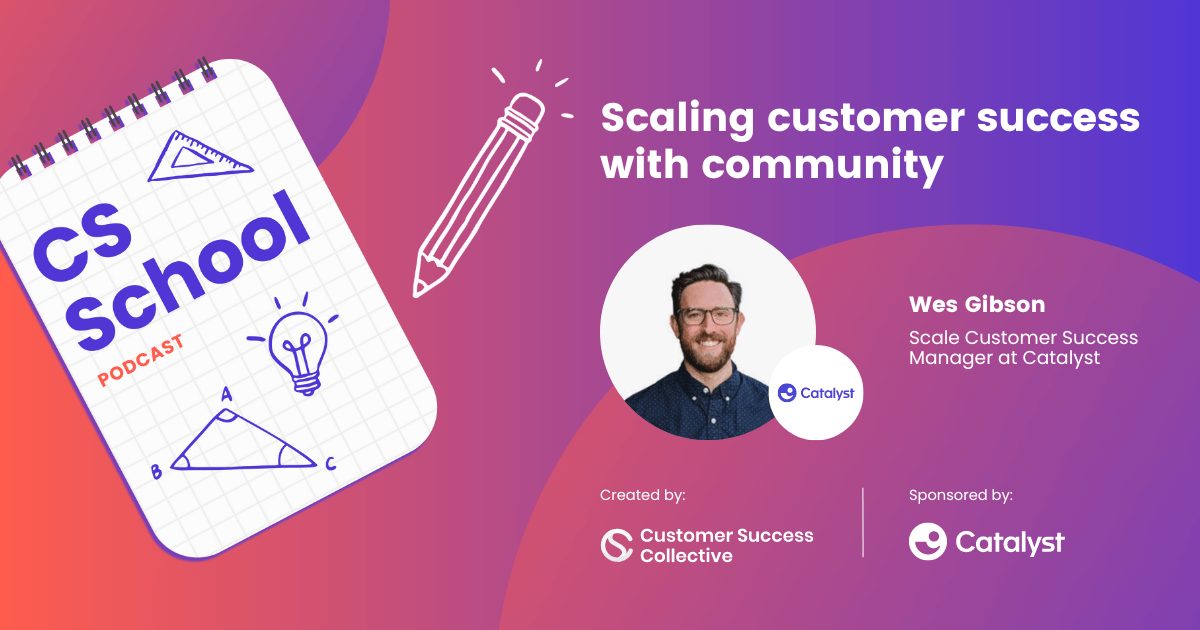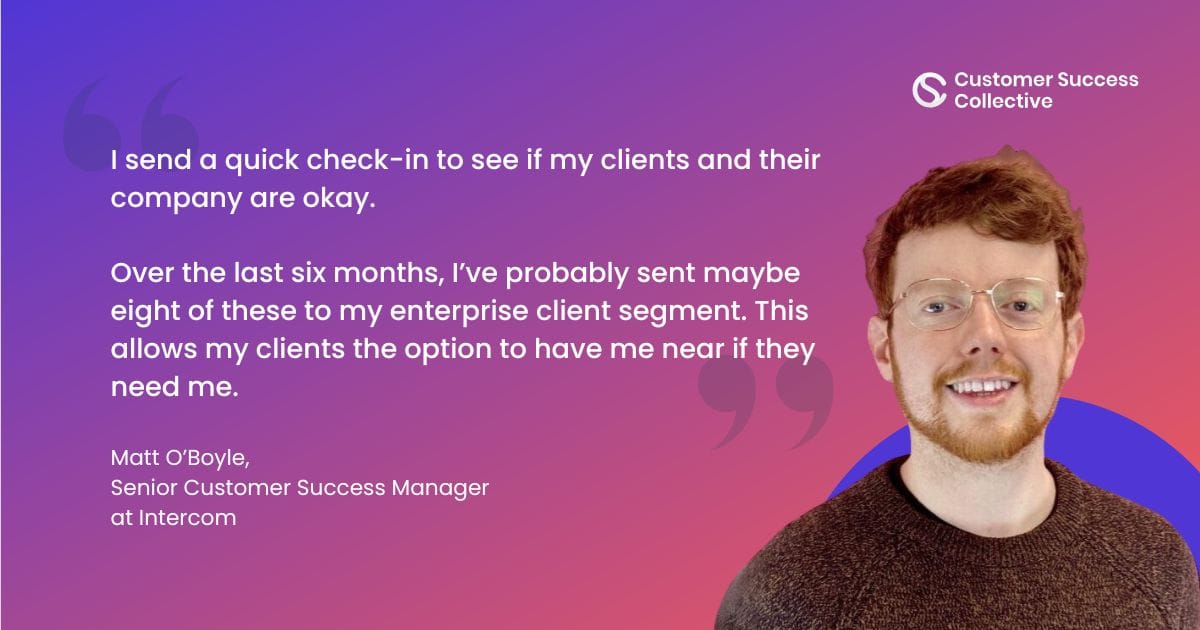Finding the time and resources to fully engage with every customer at every stage can be a real struggle.
According to Gallup, fully engaged customers offer 23% more revenue on average, but getting the balance right between newer, lower-tier customers and more established big spenders can often feel like you’re borrowing from Peter to pay Paul.
As a Customer Success Manager (CSM) at Intercom, I understand the challenges that come with keeping customers engaged and satisfied, especially for startups and companies with limited resources.
In this article, I'll share my insights on:
- Common challenges of customer engagement at scale
- How to monitor an online customer forum
- Dividing and conquering scale motions with product marketing
- Engaging with lower-tier clients when time is limited
- How to measure customer success at scale
- Intercom's focus for the next 12 months
Common challenges of customer engagement at scale
As Intercom's customer base rapidly grew, we were suddenly faced with the stark reality (and challenge!) of providing effective customer engagement at scale.
Now it must be said, that there isn't a one-size-fits-all approach to customer engagement, but here are the problems we ran into at Intercom, which you might recognize in your own organization :
1. Resource constraints
With over 500 premium accounts in the small business segment alone, our team was severely outnumbered. Managing this hefty workload while ensuring each customer received proper attention became increasingly difficult.
2. Prioritization dilemma
Deciding where to focus our limited time was a critical issue. How could we split our efforts to make the most impact and avoid neglecting valuable customers? This prioritization was crucial yet complex.
3. Churn due to lack of engagement
Some customers barely heard from us, leading to preventable churn. They were unaware of key product functionalities that could have met their needs. By the time they decided to leave for another solution, it was too late for us to rectify the situation and retain them.
4. Underutilization of product capabilities
With fewer avenues for hands-on support, many customers failed to utilize our product's full capabilities. Smaller accounts especially struggled with limited 1-on-1 time with customer success managers and longer support response times.
5. Missed growth opportunities
Inadequate customer onboarding, training on advanced features, and expansion guidance impacted our ability to maximize customer retention and growth. Customers required more proactive support to fully adopt our platform.
Overcoming these scaling challenges required strategic solutions to streamline communication, prioritize high-value engagements, and empower customers with self-service resources – all while maintaining a high-touch experiencehas.

How to monitor an online customer forum
While I don't directly run Intercom's online customer forum, our customer engagement team plays a crucial role in moderating and fostering a positive community. We have moderators who are visible to users, with their pictures, names, and businesses displayed, promoting accountability and encouraging respectful interactions.
To incentivize engagement and reward valuable contributions, we have a point system where customers who actively answer questions or participate in peer-to-peer discussions can earn gifts from Intercom.
When we first launched the forum, we even allowed non-annual customers in our small segment to access engineering time they previously couldn't, further encouraging positive behavior.

Dividing and conquering scale motions with product marketing
Like many teams out there, Intercom's customer success team has faced the common challenge of dividing and conquering scale motions between us and product marketing. Currently, I'm tackling this issue by liaising with our lifecycle management team, which delivers similar content to what I want to provide.
While the content is available, finding it can be a problem. My solution is to collaborate with the lifecycle management team and explore the possibility of taking over communications for the sales-owned accounts under my name. Even if they're not delivering fantastic content, if they're doing it at the right time, that's already half the work done for me.
With a tool like Intercom, it's easy to change the dynamic owner of messaging and control where replies go, making it more comfortable for customers to see a familiar face communicating with them. My advice would be to ensure you have an excellent communications tool where you can swap message ownership between product marketing and CSM ownership.

Engaging with lower-tier clients when time is limited
Engaging with every customer can be a real struggle, especially when you're in charge of the lowest tier of clients and don't have enough time. To address this challenge, we implemented a tiered system at Intercom.
I've split my 500 customers into three tiers based on their spending levels:
- Those who spend the most
- Those who spend moderately
- Those who spend the least
We then set expectations with each tier, outlining the level of support they can expect.
For example, brand-new customers in the lowest tier might receive two hours of onboarding time with a Customer Success Manager and one hour of ongoing support every month. This allows us to provide targeted content and videos at the right time for each customer segment.
I highly recommend using a video-recording tool like Loom for smaller customers, as it allows you to quickly record your screen and share it with them if they're having success or support issues.
How to measure customer success at scale (and know which key metrics to track)
Measuring customer engagement at scale can be a daunting task, but it's crucial for understanding the effectiveness of your efforts. At Intercom, we're still figuring out the best way to measure success at scale, but one key metric I track is touchpoints.
If a customer is having issues, we can go back and analyze how many touchpoints we had with them and how many opportunities we offered them to speak with a Customer Success Manager. This helps us identify areas for improvement and ensure we're providing adequate support.
Additionally, we closely monitor team retention and how well our team is performing. For my small business team, which oversees roughly 500 accounts with three relationship managers, these metrics are particularly important.
Intercom's focus for the next 12 months
Over the next 12 months, our focus at Intercom will be on reviewing the numbers and analyzing the effectiveness of the behavioral messaging strategies we implemented last year. We'll conduct A/B testing to identify areas for improvement and ensure our messaging resonates with customers.
Churn reduction is a significant focus, as we believe that the more we engage with customers, the less likely they are to leave, and the more comfortable they'll feel within the Intercom family.
Engagement at scale: In a nutshell
Okay, so there you have it! When scaling your customer success function, my tip is to take a multifaceted approach; from measuring the right metrics and monitoring online communities to collaborating with product marketing teams and tailoring engagement strategies for different customer tiers.
If you implement these strategies and continuously analyze our efforts, we aim to provide exceptional customer experiences and foster long-lasting relationships.


